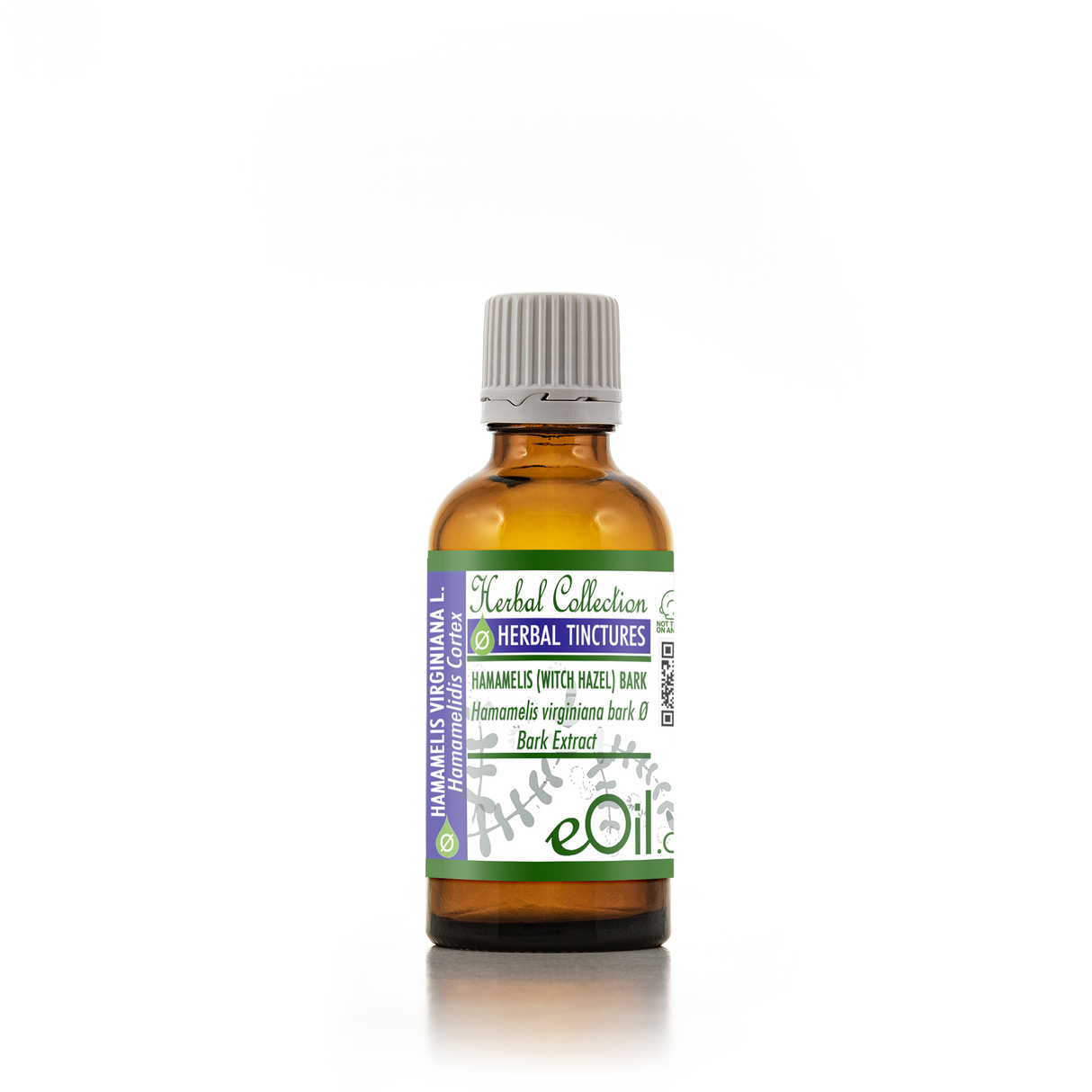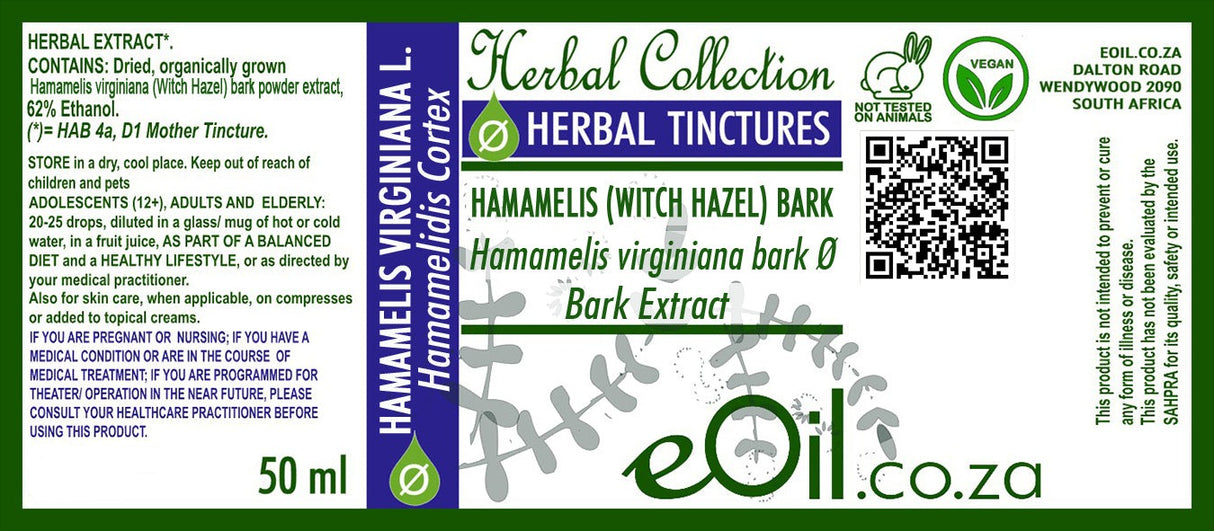Witch hazel Bark - Liquid Herbal Extract
Witch hazel Bark - Liquid Herbal Extract - 50 ML is backordered and will ship as soon as it is back in stock.
Description
Description
Understanding Mother Tinctures & Glycerines
Witchhazel Bark Liquid Herbal Extract Tincture is made from the bark of Hamamelis virginiana, a North American shrub valued for its natural astringent, anti-inflammatory, and antioxidant properties.
This tincture contains tannins and unique plant phytonutrients, supporting gentle wellness routines.
Traditionally used to help tone skin and support comfort for adults. Ethically sourced with no artificial additives.
TRADITIONALLY USED FOR
May help with
Witch Hazel Bark & Witch Hazel Leaf (Hamamelis virginiana) Liquid Herbal Extract Tinctures
Astringent herbal care for skin, wounds, and vein support—gentle, pure, and rapid-action from America’s classical medicinal shrub.
Witch Hazel Bark Tincture
Astringent & Skin Healing: Bark extract is especially rich in tannins for astringency, helping tighten tissues, reduce swelling, and support faster healing of minor wounds, cuts, and scrapes.
Vein & Circulation Support: Widely used to tone and soothe varicose veins, piles (hemorrhoids), mild bleeding, and to strengthen fragile or inflamed capillaries.
Antiseptic & Anti-inflammatory: Supports mild inflammation, skin irritation, insect bites, rash, and as a soothing mouthwash for sore gums or ulcers.
Quick-Absorbing & Versatile: Perfect for wellness kits and topical blends—faster effects than gels, and easily mixed for compress/soak solutions.
Directions
Adults: 1–2 ml (20–40 drops) in water up to 3x daily OR apply diluted tincture with cotton pad to affected skin/topically.
Not for: Direct use on deep wounds, eyes, or oral cavities in children.
Witch Hazel Leaf Tincture
Gentler Astringent & Soothing: Leaf extract is milder than bark, often favored for sensitive skin, facial toner blends, and gentle wound treatment.
Relief for Itch, Redness, & Irritation: Supports comfort in minor eczema, insect stings, scalp itch, allergic skin flare-ups, and mild sunburn.
Mucous Membrane & Oral Health: Used as a mild mouth rinse or gargle for puffy gums, sore throats, or minor oral inflammation.
Customizable for Daily Skincare: Easy to add to custom mists, balms, or sitz baths.
Directions
Adults: 1–2 ml (20–40 drops) in water 2–3x daily, or dilute for topical use in gentle skincare protocols.
Not for: Use in open wounds, children under 6, or pregnancy except under healthcare guidance.
Witch Hazel Tincture Comparison Table
| Product Type | Main Benefits | Dosage & Use | Best For | Not For / Cautions |
|---|---|---|---|---|
| Bark | Strong astringent, wounds, veins | 1–2 ml (20–40 drops) 2–3x daily, or topical | Varicose veins, hemorrhoids, strong skin repair | Deep wounds, internal use, pregnancy |
| Leaf | Gentle astringent, skin, oral | 1–2 ml (20–40 drops) 2–3x daily, or topical | Sensitive skin, scalp, puffy gums, facial toner | Open wounds, kids <6, long-term use |
INFORMATION
Source : http://www.wikiphyto.org/wiki/Witchhazel
Reference on http://www.wikiphyto.org
Translation in English by Google Translate (go to the page of the source linked | on Chrome cellphones go on the 3 dots on the top right and select translate in your preferred language | on laptop right click your mouse and select option translate when hoovering on the page
plant name
Witch Hazel , Witch Hazel
International Latin denomination
botanical family
Hamamelidaceae
Description and habitat
- Spontaneous in the eastern part of the American continent (from Quebec to Virginia)
- Shrub about 7 m high, with flexuous branches reminiscent of the hazel tree
- The flowers bloom in the fall, after the leaves have fallen
- Very elegant winter flowering, on the still bare branches
History and tradition
- Used in Native American medicine
- Native Americans used the flexible branches of the shrub to make bows
- Witch hazel was used in beard lotions in Quebec, due to its hemostatic, astringent and anti-inflammatory properties [3].
- In English, witch hazel is called digitalis of the veins or hazel of the witches .
Parts used
- dried leaf
Dosage forms available
- Hamamelis virginiana leaf and bark tincture
- Fluid extract
- Dry extract
Usual dosages
Composition
Main components of the plant
- Tannins (+ 10%, at least 3% for the European Pharmacopoeia expressed in pyrogallol ):
- Ellagitanins ( gallic acid , pentagalloylglucose , hamamelitanin )
- Catechic tannins ( catechin , gallocatechin , epicatechin , epigallocatechin ), proanthocyanidols , procyanidols , procyanidol - prodelphinidol copolymers
- Flavonoids : flavonol glycosides ( astragaloside , myricitroside , isoquercitroside ), kaempferol and quercetol glycosides
- 0.01 to 0.5% essential oil : aliphatic alcohols, esters , carbonyl compounds
- Organic acids : caffeic acid , quinic acid , gallic acid , fatty acids
- It is a hydroalcoholic extraction at 30° of ethanol which produces the maximum amount of ethyl gallate from gallic acid .
Main components of buds or young shoots
Main components of essential oil
Properties
Plant properties
- Vasoconstricteur
- Antiphlogistic and anti-inflammatory [1] , [2]
- Bacteriostatic and molluscicidal, certain hamamelitanin derivatives potentiate vancomycin in the treatment of infections resistant to Staphylococcus aureus (MRSA) by action on the biofilm [3] , [4] , inhibition of Quorum Sensing (molecular signals regulating the density of a bacterial population) by hamamelitanin [5]
- Protector of vascular endothelium, hamamelitanin inhibits TNF-mediated endothelial cell death without modifying endothelial adhesiveness, anti-hemorrhagic activity, protective agent against UV radiation [6] [7]
- Tonic
- Astringent (property of tightening the tissues)
- Action on varicosities (alterations of the fine and superficial vascular wall, at the interface between the arterial and venous network, often red or bluish)
- Reduces UVB-induced erythema [8]
- Antimutagenic [9]
- Anti-radical and antioxidant [10] , [11]
Bud properties
Properties of essential oil
Indications
Indications of the whole plant (phytotherapy)
- Venous insufficiency
- Lesions of the skin, mucous membranes, capillaries
- Hemorrhoids, varicose veins
- Menorrhagia, dysmenorrhea, hematuria
- Dysentery, diarrhoea, colitis
- Local route: eye irritation or discomfort, oral hygiene
- Positive clinical study in atypical neurodermatitis: leaf extract in cream form
Indications of the bud (gemmotherapy)
Specific indications of essential oil (aromatherapy)
Known or suspected mode of action
- Property to tighten the tissues ( tannins )
- Gallic acid produces ethyl gallate with astringent and antibacterial properties
Usual formulations
Regulations
- French Pharmacopoeia list A (stem bark, leaf)
- Activity recognized by the German Commission E
Possible side effects and precautions for use
- Rare cases of hepatotoxicity by tannins
Bibliographic references
- Go↑ Duwiejua M, Zeitlin IJ, Waterman PG, Gray AI. Anti-inflammatory activity of Polygonum bistorta, Guaiacum officinale and Hamamelis virginiana in rats. J Pharm Pharmacol. 1994 Apr;46(4):286-90. PMID 8051612
- Go↑ H. C. Korting, M. Schäfer-Korting, H. Hart, P. Laux, M. Schmid. Anti-inflammatory activity of hamamelis distillate applied topically to the skin. European Journal of Clinical Pharmacology, Volume 44, Number 4, 315-318 [1]
- Go↑ Vermote A, Brackman G, Risseeuw MDP, Coenye T, Van Calenbergh S. Design, synthesis and biological evaluation of novel hamamelitannin analyste logues as potentiators for vancomycin in the treatment of biofilm related Staphylococcus aureus infections. Bioorg Med Chem. 2016 Oct 1;24(19):4563-4575. doi: 10.1016/j.bmc.2016.07.058. PMID 27507109
- Go↑ Vermote A, Brackman G, Risseeuw MDP, Coenye T, Van Calenbergh S. Novel hamamelitannin analogues for the treatment of biofilm related MRSA infections-A scaffold hopping approach. Eur J Med Chem. 2017 Feb 15;127:757-770. doi: 10.1016/j.ejmech.2016.10.056. PMID 27823882
- Go↑ Brackman G, Breyne K, De Rycke R, Vermote A, Van Nieuwerburgh F, Meyer E, Van Calenbergh S, Coenye T. The Quorum Sensing Inhibitor Hamamelitannin Increases Antibiotic Susceptibility of Staphylococcus aureus Biofilms by Affecting Peptidoglycan Biosynthesis and eDNA Release. Sci Rep. 2016 Feb 1;6:20321. doi: 10.1038/srep20321. PMID 26828772
- Go↑ Habtemariam S. Hamamelitannin from Hamamelis virginiana inhibits the tumour necrosis factor-alpha (TNF)-induced endothelial cell death in vitro. Toxicon. 2002 Jan;40(1):83-8. PMID 11602283
- Go↑ Solomon Habtemariam. Hamamelitannin from Hamamelis virginiana inhibits the tumour necrosis factor-α (TNF)-induced endothelial cell death in vitro. Toxicon, Volume 40, Issue 1, January 2002, Pages 83-88
- Go↑ B.J. Hughes-Formella, K. Bohnsack, F. Rippke, G. Benner, M. Rudolph, I. Tausch, J. Gassmueller. Anti-Inflammatory Effect of Hamamelis Lotion in a UVB Erythema Test. Dermatology 1998;196:316-322
- Go↑ Andreas Dauer, Petra Metzner, Oskar Schimmer. Proanthocyanidins from the Bark of Hamamelis virginiana Exhibit Antimutagenic Properties against Nitroaromatic Compounds. Planta Med 1998; 64(4): 324-327
- Go↑ Masaki H, Sakaki S, Atsumi T, Sakurai H. Active-oxygen scavenging activity of plant extracts. Biol Pharm Bull. 1995 Jan;18(1):162-6. PMID 7735233
- Go↑ Alda Pereira da Silva, Rui Rocha, Cristina M. L. Silva, Lurdes Mira, M. Filomena Duarte, M. Helena Florêncio. Antioxidants in medicinal plant extracts. A research study of the antioxidant capacity of Crataegus, Hamamelis and Hydrastis. Phytotherapy Research, Volume 14, Issue 8, pages 612–616, December 2000 [2]
- Bruneton J. Pharmacognosy, Phytochemistry, Medicinal Plants. Ed. Tec and Doc. 1997.
- A. Dauer, H. Rimpler, A. Hensel. Polymeric Proanthocyanidins from the Bark of Hamamelis virginiana. Planta Med 2003; 69(1): 89-91
CAUTION
Store in a cool, dry place, away from light. Keep tightly closed, away from the reach of Children and pets.
Do not exceed the daily dose.
This product is not intended to prevent or cure any form of illness or disease.
If you are pregnant or nursing ; If you have a medical condition or are in the course of medical treatment ; If you are programmed for theater/operation in the near future, please consult your healthcare practitioner before using this product.
This product cannot replace a varied and balanced diet and a healthy lifestyle.
This product has not been evaluated by the SAHPRA for its quality, safety or intended use.
For More Information please check our General Safety Herbal products Page

Witch hazel Bark - Liquid Herbal Extract - 50 ML is backordered and will ship as soon as it is back in stock.





